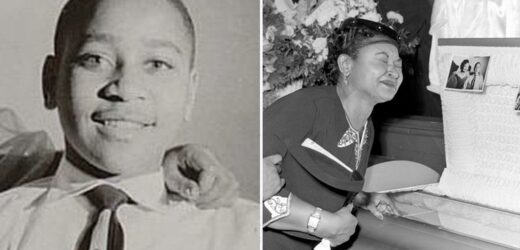EMMETT Till's mom Mamie was forced to identify her son using a ring he wore after the 14-year-old's body was mutilated beyond recognition when he was lynched in 1955.
Mamie Till Mobley is praised as a civil rights leader for her battle for justice for Emmett, whose murderers admitted in a magazine interview that they were responsible a year after they were found not guilty at trial.

Her fight for the truth will be explored in Women of the Movement to air on ABC on Thursday as it looks back on her decades as a speaker and activist.
Emmet Till was killed by Roy Bryant and his half-brother JW Milam in Mississippi in August 1955 after Bryant's wife Carolyn claimed the teen whistled at her.
Enraged, the men kidnapped Emmett from his uncle's house and tortured him before drowning the teen.
Emmet had been visiting relatives in Money, Missiipose, from his native Chicago and his mother was miles away when the call came in to report him missing.
Mamie was originally from Mississippi but moved to Chicago with her parents during the "Great Migration."
She met Emmet's father Louis Till when she was 18 years old.
Most read in The Sun
FIRST CASE I'm first Brit to catch bird flu – I'm devastated my beloved ducks were killed
Thousands of families can apply for £340 free cash from TODAY
Sue Radford is 'so proud' of son Luke, 21, as he comes out as gay on TV show
I have men falling at my feet asking for dates – until they realise my age
They married in 1940 and Emmet was born less than a year later in July 1941.
Mamie and Louis separated shortly afterward and she got a restraining order against him, according to Newsweek, before he was drafted into the Army.
After his death during the war, Mamie was sent back a ring Louis bought with his initials engraved on it, which she gifted to her young son.
Mamie has said that she harshly learned about the truth of racial injustice in the south as a pre-teen when she went to a local white-owned drugstore in Mississippi to buy toilet paper while on a trip from Chicago.
She wrote that her grandfather "pounded the fear of every black person in the state of Mississippi into [her]” for daring to try and buy the toilet paper.
“In Mississippi, there were certain things that black people were denied by white people," she said.
"The freedom of movement. The luxury of choice. And a roll of toilet paper.”
'CRASH COURSE IN HATRED'
As Emmet grew older, Mamie was reportedly aware that he would not understand the differences between Chicago and Mississippi, and she had been nervous about his trip to the southern state.
She said that she gave her 14-year-old a "crash course in hatred" before he went in an attempt to explain the segregation he would encounter there.
“How do you give a crash course in hatred to a boy who has only ever known love?” she wrote, according to the NPCA.
Mamie added that she told him to say “yes, ma’am” and “no, sir” when talking to white people and to bow his head and get off the sidewalk if a white woman was working toward him.
Yet in an apparent act of teenage daring, Emmet whistled at the woman while his cousins claimed he was simply whistling while she was around.
Four days later he was taken and his body was found tied to a cotton gin fan and dumped in the nearby Tallahatchie River.
It was the ring sent home from the war after his father's death that was used to identify Emmett due to the condition of his body.
After Emmet's death, Mamie reportedly paid the equivalent of $34,000 – a year's salary – to bring her son back to Chicago.
CASKET LEFT OPEN
Thanks to the family's quick thinking in calling up newspapers the day he was reported missing, by the time his body arrived in the train station in Chicago, Emmett was greeted by throngs of spectators and reported.
Mamie was praised for her decision to leave Emmet's casket open at his funeral, despite the gruesome injuries he had sustained.
It meant that mourners could see the extent of the brutality used against Emmet and photographs of his body spread the image around the world.
While undertakers on both Mississippi and Chicago -and even her own relatives – had signed for the coffin to be sealed, she fought to have it opened and then to remain open for the funeral.
“Let the world see what they did to my son,” she told the funeral home director while in the presence of Jet magazine reporter Simeon Booker, who would share Emmet's story.
Ten of thousands of people filed past his coffin with nurses on hand to help those who fainted.
The teen's partially decomposed corpse was dressed in a dark suit and white shirt he had received the Christmas before.
A picture of him from that Christmas in the same clothes was placed in front of the coffin to highlight the destruction his murderers had on his body.
MAMIE'S FIGHT
Emmet's killers were charged with his murder in 1955 but an all-white, all-male jury cleared them after only 67 minutes of deliberation.
“If we hadn’t stopped to drink pop, it wouldn’t have taken that long," one juror said, according to the Wall Street Journal.
Their defense team had claimed that Mamie was working with the NAACP and had faked her son's death by digging up a body at the elementary.
Yet they admitted their crime to the magazine a year later as they could not be tried on the same charges twice under the double jeopardy rule.
Despite this, Mamie continued to fight to punish those responsible for the rest of her life.
She worked as an activist and on educating people about racial injustice, writing a memoir on the 50th anniversary of Emmett's death named Death of Innocence: The Story of the Hate Crime that Changed America.
And 18 years after the murder while she was working as an elementary school teacher, she established the group "The Emmett Till Players" to help educate children about the civil rights movement.
"I realized that Emmett had achieved the significant impact in death that he had been denied in life," she wrote in her memoir.
"Even so, I had never wanted Emmett to be a martyr. I only wanted him to be a good son.
"Although I realized all the great things that had been accomplished largely because of the sacrifices made by so many people, I found myself wishing that somehow we could have done it another way."
NO CONVICTIONS
Emmet's case was reopened in 2004 by the FBI as they sought to see if accomplices could still be charged.
However, a grand jury decided there was insufficient evidence to lead to charges in 2007.
Nobody has ever been convicted in relation to Emmet's lynching and the US Justice Department announced in December 2021 that its investigation is officially closed.
Emmett's death is considered one of the most prominent murders in the civil rights movement.
Only a month later, Rosa Parks would refuse to take a seat at the back of a bus in Mongomery, Alabama, saying afterward that she thought of Emmet Till as she did so.
“I thought of Emmett Till, and when the bus driver ordered me to move to the back, I just couldn’t move," Parks claimed.
The Emmett Till and Mamie Till-Mobley Institute was opened on what would have been Mamie's 100th birthday in November 2021.
She died of heart failure on January 6, 2003, and had continued to speak out for her son around the country until the end.
"Although I have lived so much of my life without Emmett, I have lived my entire life because of him," she said.


We pay for your stories!
Do you have a story for The US Sun team?
Email us at [email protected] or call 212 416 4552.
Like us on Facebook at www.facebook.com/TheSunUS and follow us from our main Twitter account at @TheSunUS
Source: Read Full Article









